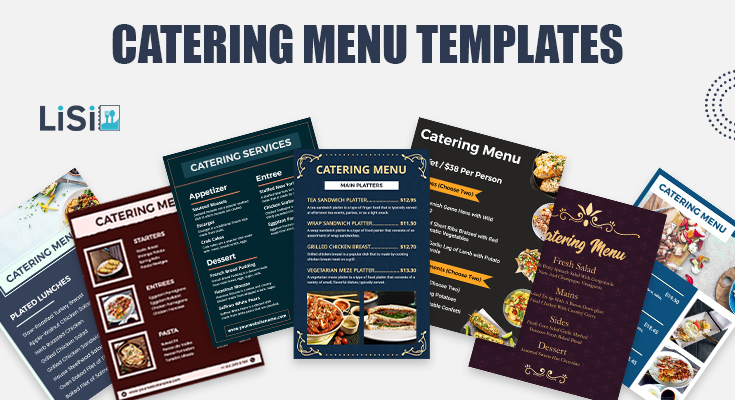Planning an event means making countless decisions. However, one choice stands above all others: your catering menu. Yet, using and customizing catering menu templates can truly wow guests. Moreover, many don’t realize that a poorly planned catering menu can turn their dream event into a disappointing experience.
So, what makes the difference between a forgettable meal and one that guests talk about for years? In this comprehensive guide, we’ll explore creative catering menu templates that leave lasting impressions.
What is a Catering Menu Template?
A Catering Menu Template is a ready-made layout or design that helps you list all the food and drink options you offer for a catering event.
Think of it like a blank form where you can fill in your dishes, prices, and details, so it looks neat and professional when you show it to customers. It makes creating a menu easier and faster because you don’t have to start from scratch every time!
Additionally, it balances taste, presentation, dietary needs, and budget considerations seamlessly. Catering menu is a type of prix fixe menu, offers a pre-set number of courses at a set price, often with limited choices for each course.
What are the Best Examples of Catering Menus?
Here are a few popular examples and types of catering menu templates that are great for different types of events: You can easily customize menu templates and create the best one that not only captures attention but also boosts your orders.
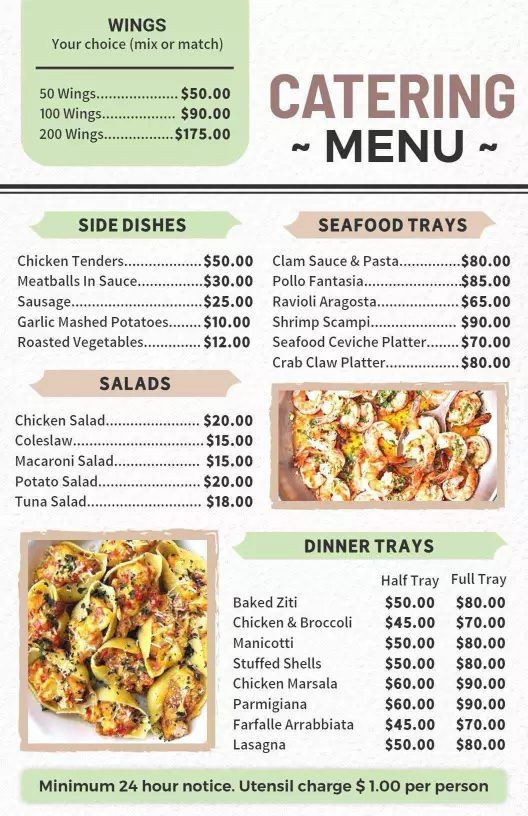
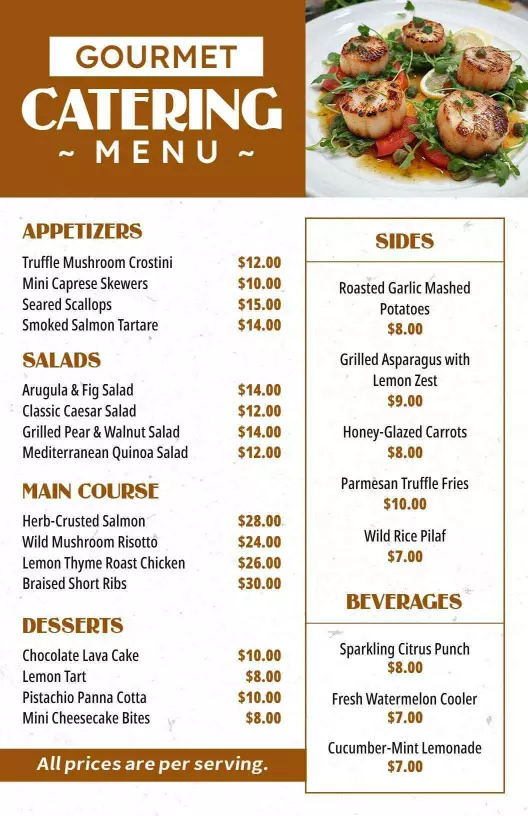
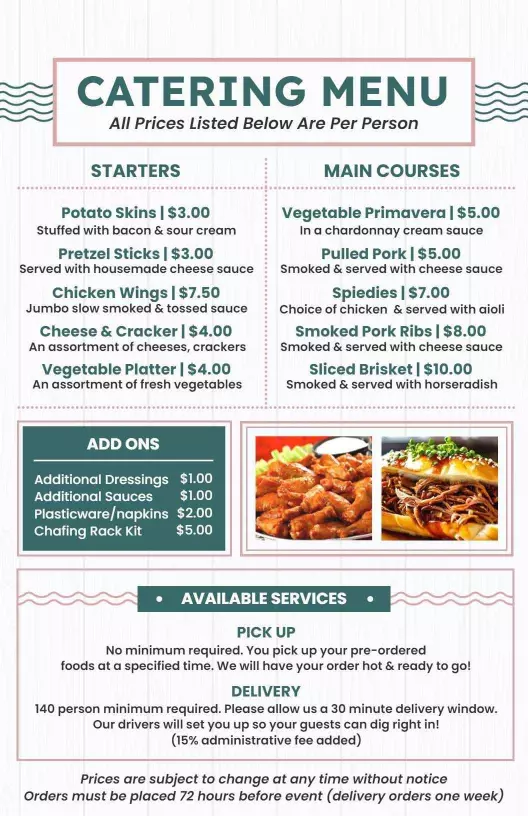
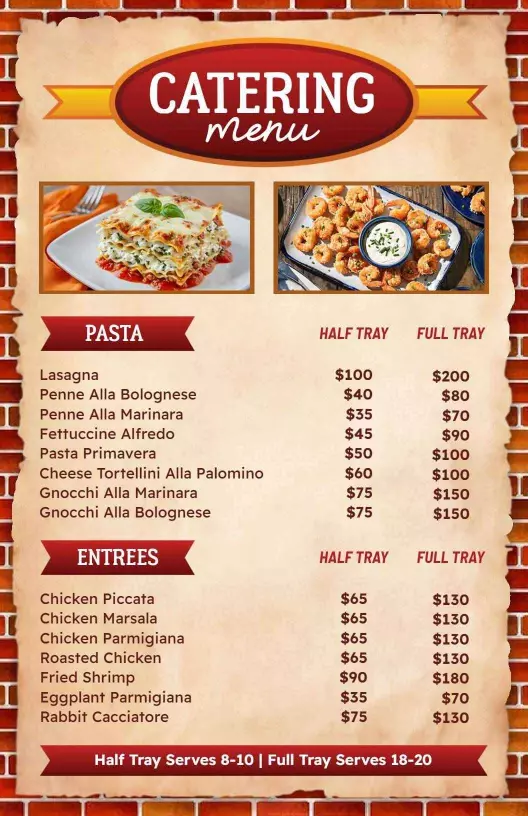
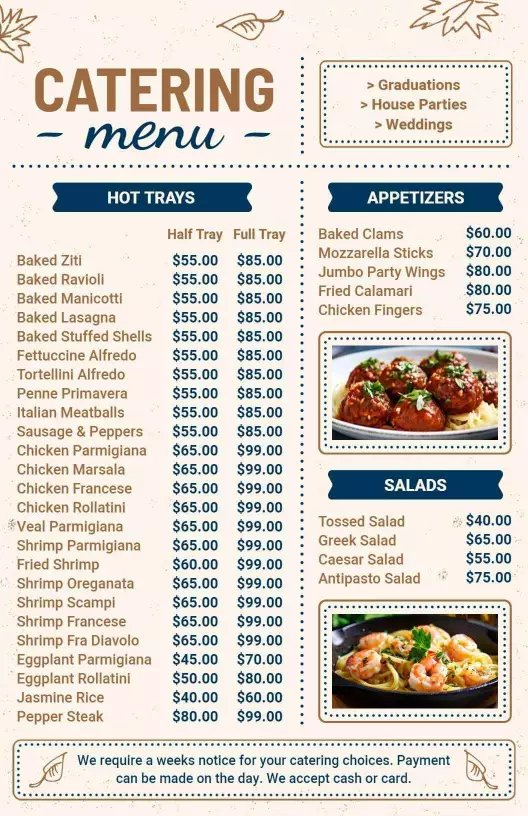
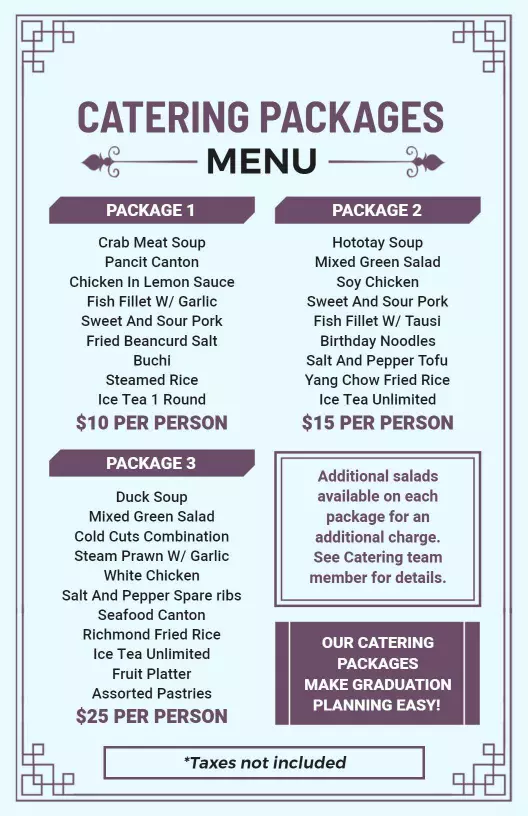
How to Design Your Catering Menu that Stands Out?
Creating memorable catering experiences requires going beyond standard offerings to deliver something uniquely meaningful. Moreover, distinctive menus often become talking points that extend your event’s impact far beyond the actual occasion.
Here are the best practices and ideas for designing a catering menu.
1. Start With Your Story
Every great catering menu begins with a clear story or theme. Therefore, ask yourself what makes your event special and unique. Furthermore, consider how your food choices can reflect that uniqueness.
Define Your Event’s Personality:
- What emotions do you want guests to feel?
- What memories do you want to create?
- How formal or casual should the atmosphere be?
- What cultural or personal elements matter most?
For example, a company anniversary might celebrate growth and innovation through fusion dishes that blend traditional recipes with modern techniques. Meanwhile, a wedding could honor family heritage by featuring a grandmother’s recipes alongside contemporary favorites.
2. Create Visual Impact Through Presentation
Outstanding catering menus focus heavily on how food looks, not just how it tastes. Additionally, creative presentations become conversation starters that enhance the overall event experience.
Eye-Catching Display Ideas:
- Use height variations with tiered serving stands
- Incorporate fresh flowers or greenery as natural decorations
- Choose serving dishes that complement your event’s color scheme
- Add lighting elements like candles or string lights around food stations
Interactive Food Stations: Interactive elements transform passive eating into engaging experiences. Furthermore, these stations often become the event’s most photographed and talked-about features.
- Live cooking demonstrations where chefs prepare dishes in front of guests
- Build-your-own bars for tacos, pasta, or salads
- Carving stations with premium meats
- Dessert decoration stations where guests customize their treats
3. Incorporate Unique Flavor Combinations
Bold flavor pairings set your menu apart from typical catering offerings. However, balance creativity with familiarity to ensure broad appeal while still surprising guests.
Fusion Approach Examples:
- Korean BBQ sliders with kimchi slaw
- Mediterranean-inspired flatbreads with local cheese
- Mexican street corn salad with quinoa
- Asian-fusion lettuce wraps with local vegetables
Seasonal and Local Focus: Using seasonal, local ingredients creates freshness while supporting community businesses. Moreover, guests appreciate knowing where their food comes from.
- Partner with local farms for vegetables and herbs
- Feature regional specialties that reflect your location
- Adapt menu items based on seasonal ingredient availability
- Share stories about local producers with your guests
4. Write Memorable Menu Descriptions
How you describe your food in the menu significantly impacts guest excitement and expectations. Therefore, craft descriptions that paint pictures and tell stories rather than simply listing ingredients.
Instead of: “Chicken with vegetables,” Write: “Herb-crusted free-range chicken with roasted rainbow carrots and garden-fresh green beans.”
Instead of: “Chocolate cake,” Write: “Decadent triple-chocolate torte with Madagascar vanilla cream.”
Effective Description Techniques:
- Use sensory words that help guests imagine tastes and textures
- Include cooking methods that suggest quality and care
- Mention ingredient origins when they add value
- Keep descriptions concise but evocative
5. Focus on Dietary Inclusivity
Outstanding catering menus ensure every guest feels valued and included. Therefore, plan diverse options from the beginning rather than treating special diets as afterthoughts.
Inclusive Menu Planning:
- Offer substantial vegetarian and vegan options alongside meat dishes
- Provide clearly marked gluten-free choices
- Include dairy-free alternatives for common dishes
- Ensure special dietary options are equally appealing and well-presented
Smart Integration Strategies:
- Design naturally inclusive dishes that work for multiple dietary needs
- Use creative substitutions that enhance rather than compromise flavors
- Train serving staff to discuss options knowledgeably
- Place special dietary options prominently rather than hiding them
6. Leverage Technology and Innovation
Technology is evolving, and changing the way to create a menu using AI. Modern catering menus can incorporate technology to enhance guest experience and create memorable moments. Additionally, these innovations often become talking points that extend your event’s impact.
Digital Integration Ideas:
- Creating QR menus and linking to ingredient sources and nutritional information
- Social media walls displaying guest food photos
- Digital menu boards that update in real-time
- Interactive displays showing preparation processes
Sustainable Innovation:
- Compostable or reusable serving materials
- Zero-waste preparation methods
- Plant-forward options that reduce environmental impact
- Partnerships with sustainable local suppliers
7. Keep It Updated and Seasonal
Keeping your catering menu updated and seasonal is one of the simplest yet most powerful ways to stand out and stay relevant. Customers love fresh, timely offerings—especially when they feature ingredients that are in season. Updating your menu regularly (every 3 to 6 months) shows that your business is active, creative, and responsive to trends.
Additionally, refreshing your menu helps remove low-performing dishes, add popular trends (like plant-based or gluten-free options), and keep your brand feeling fresh. A regularly updated, seasonal menu signals professionalism, attention to detail, and a commitment to quality—traits that clients truly value when choosing a catering service.
8. Smart Pricing Strategy
Clear and smart pricing means your customers should easily understand what they’re paying for. Avoid confusing terms or hidden costs. List prices in a simple way—like per person, per tray, or as part of a package—so clients can quickly calculate their total.
Also, be honest about any extra fees, like delivery, staff, or cleanup charges. When prices are clear, it builds trust and helps customers make decisions faster.
Smart pricing also means offering value. Create menu packages at different price levels so customers can choose what fits their budget. You can even offer add-ons (like drinks or desserts) to boost your sales in a friendly way. This makes your menu flexible, easy to understand, and more appealing to potential clients.
9. Offer Tastings and Sample Packages
Offering tastings and sample packages means giving potential clients a chance to try your food before they book your catering service. This is especially helpful for big events like weddings, corporate parties, or special celebrations.
A tasting lets clients see the quality, taste, and presentation of your dishes. It builds trust and helps them feel confident that you’re the right choice. You can invite them to a small tasting session or provide a sample box with a few menu items.
What are the Core Elements Every Great Catering Menu Needs?
First and foremost, understanding your audience forms the foundation of menu success. Furthermore, consider these essential components:
- Event type alignment – Corporate events require different approaches than weddings
- Guest demographics – Age groups and cultural backgrounds influence food preferences
- Dietary restrictions – Vegetarian, vegan, gluten-free, and allergy considerations
- Service style – Buffet, plated, family-style, or cocktail reception formats
- Budget parameters – Cost per person affects ingredient quality and menu complexity
- Seasonal availability – Fresh, local ingredients often taste better and cost less
Meanwhile, successful caterers also consider the venue’s kitchen capabilities and service limitations. Consequently, the process of designing a menu works within these practical constraints while still delivering exceptional experiences.
How Do Different Event Types Shape Your Catering Menu Choices?
Understanding your event type helps you make smarter menu decisions. Moreover, each occasion brings unique expectations and requirements that directly impact guest satisfaction.
Corporate Catering Menus:
Corporate events demand menus that maintain professionalism while keeping attendees engaged. Therefore, focus on foods that are easy to eat during presentations or networking sessions.
Breakfast menu:
- Continental spreads with pastries, fresh fruit, and coffee
- Hot breakfast items like breakfast burritos or quiche
- Healthy options include yogurt parfaits and granola
Lunch Presentations:
- Sandwich platters with gourmet ingredients
- Salad bars with protein options
- Soup and sandwich combinations
Evening Networking Events:
- Elegant hors d’oeuvres that spark conversation
- Wine and cheese pairings
- Light finger foods that don’t require utensils
Subsequently, corporate catering menus should also accommodate various dietary preferences without making anyone feel excluded.
How Do You Handle Special Dietary Requirements in Your Catering Menu?
Today’s catering menus must accommodate diverse dietary needs without making anyone feel excluded or different. Moreover, proactive planning for special requirements often leads to creative menu solutions that benefit all guests.
Common Dietary Restrictions and Solutions
Understanding prevalent dietary needs helps you plan inclusive menus from the start. Furthermore, addressing these requirements during initial planning prevents last-minute scrambling and ensures better food quality.
Vegetarian and Vegan Options:
- Create substantial plant-based proteins rather than just removing meat
- Use cashew or coconut-based sauces for richness
- Incorporate quinoa, lentils, and beans for protein completeness
- Ensure cooking methods and ingredients align with dietary restrictions
Gluten-Free Accommodations:
- Provide naturally gluten-free options alongside substitutions
- Use separate preparation areas and utensils to prevent cross-contamination
- Label all items clearly for guest identification
- Train serving staff about ingredient contents and preparation methods
Allergy Considerations:
- Identify the eight major allergens in all menu items
- Create allergen-free zones in preparation and serving areas
- Develop emergency response protocols with venue staff
- Maintain detailed ingredient lists for all prepared foods
Cultural and Religious Dietary Laws:
- Understand kosher, halal, and other religious dietary requirements
- Source appropriate ingredients and preparation methods
- Coordinate with certified suppliers when necessary
- Respect cultural preferences in ingredient selection and preparation
Therefore, inclusive menu planning demonstrates respect for all guests while often inspiring creative culinary solutions.
Creating Inclusive Menu Designs
Successful inclusive menus integrate special dietary options seamlessly rather than segregating them. Additionally, this approach often results in healthier and more interesting food choices for everyone.
Integration Strategies:
- Design naturally inclusive dishes that work for multiple dietary needs
- Use creative labeling that highlights positive attributes rather than restrictions
- Ensure special dietary options are equally appealing and well-presented
- Train staff to discuss options knowledgeably and enthusiastically
Communication Best Practices:
- Collect dietary information during the RSVP process
- Follow up with guests who have complex requirements
- Coordinate with caterers well in advance of the event
- Provide clear signage and information at the event
Subsequently, thoughtful accommodation of dietary needs often becomes a memorable aspect of your event that guests appreciate long afterward.
What Menu Planning Mistakes Should You Avoid at All Costs?
Creating a menu might seem easy, but any mistake while designing can lead to customer confusion, poor sales, and even food waste. Here are the most common menu planning mistakes you should avoid at all costs.
1. Offering Too Many Items
Having too many choices can overwhelm your customers and slow down their decision-making. A large menu also makes it harder for your kitchen to manage ingredients, prepare food quickly, and maintain consistency.
Why It’s a Problem:
- Increases prep time and inventory costs
- Confuses customers
- Leads to waste from unused ingredients
Solution: Focus on a smaller, well-curated menu with your best and most profitable items. Make every item count.
2. Ignoring Your Target Audience
Not every dish suits every customer. If your menu doesn’t match what your audience wants, they may not return. For example, a health-conscious crowd might not appreciate a menu full of deep-fried items.
Why It’s a Problem:
- Fails to meet customer expectations
- Makes your business feel out of touch
Solution: Understand your audience—families, office workers, students, tourists—and plan your menu around their preferences and lifestyle.
3. Poor Menu Layout and Design
Even if your food is great, a confusing or cluttered menu can turn people off. If the menu is hard to read or doesn’t guide the customer’s eye, they may skip over your best dishes.
Why It’s a Problem:
- Makes ordering harder
- Reduces the chances of upselling
- Looks unprofessional
Solution: Use clear fonts and colors for menu design, sections, and spacing. Highlight popular items or chef’s specials. A clean, organized layout improves customer experience.
4. Lack of Variety and Balance
Too much repetition or offering only one type of dish can make your menu boring. Customers want choices that suit different tastes and diets.
Why It’s a Problem:
- Limits your customer base
- Makes your brand feel one-dimensional
Solution: Include a balance of:
- Meat and vegetarian options
- Sweet and savory items
- Light and filling dishes
Also, consider dietary needs like gluten-free or vegan.
5. Not Pricing Items Correctly
Incorrect pricing is one of the biggest mistakes in menu planning. If you price items too low, you lose profit. If prices are too high, you might lose customers.
Why It’s a Problem:
- Low profits or poor customer retention
- Misrepresents the value of your food
Solution: Consider food costs, preparation time, and what your target customers are willing to pay. Use psychological pricing (e.g., $8.99 instead of $9.00) to encourage purchases.
6. Copying Competitors Without Being Unique
Copying what other restaurants or caterers offer may seem like a quick way to create your menu, but it can hurt your business. If your menu looks exactly like your competitor’s, customers won’t have a reason to choose you over them.
When you offer the same dishes, the same names, and the same menu styles, your brand becomes forgettable. People love trying something different, and being unique helps your business stand out.
Instead of copying, take inspiration and then add your twist, like using special ingredients, adding a family recipe, or giving your dishes creative names. Show your personality through your menu. That’s what makes your food memorable and gives customers a reason to come back.
7. Failing to Highlight Best-Selling or High-Profit Items
If you don’t highlight your most popular or most profitable menu items, many customers might overlook them. People often glance through a menu quickly, so they might miss your best dishes unless you guide their attention.
These “star” items are not only customer favorites, but they also bring in more money for your business. By not pointing them out, you’re missing a chance to boost both satisfaction and sales.
Make these dishes stand out by using boxes, icons (like a star or chef’s hat), or bold text. Place them in spots where customers look first, like the top or middle of the menu. This simple trick helps more people choose the items that work best for your business.
Recommended reading: if you’re planning to create a drink menu, but are afraid that it will fail, learn about mistakes to avoid while creating a drink menu.
Should You Create Different Catering Menus for Different Types of Events?
Yes, you should definitely create different catering menus for different types of events. Each event is unique and comes with its own theme, guest expectations, and food preferences. A one-size-fits-all menu might not work for every occasion, but offering tailored menus shows that you understand your clients’ needs and are ready to give them the best experience.
Let’s say you’re catering a wedding, a corporate lunch, and a kid’s birthday party. These events are completely different in terms of style, setting, and the kind of food people expect.
- Creating a wedding menu often calls for elegant, plated meals or gourmet buffets with a mix of appetizers, mains, and desserts.
- Corporate events usually prefer quick, easy-to-eat meals like boxed lunches, sandwiches, or finger foods that don’t interrupt meetings.
- Birthday parties, especially for kids, may need fun and simple dishes like mini pizzas, sliders, or sweet treats.
Using the same menu for all these events wouldn’t make sense—and might even disappoint your clients.
Frequently Asked Questions
1. What are the key elements of a well-designed catering menu?
A well-designed catering menu includes a clear structure, a variety of food options, customizable choices, and simple pricing. It should be divided into sections like appetizers, mains, sides, desserts, and beverages. A good menu also highlights popular or signature items and includes dietary labels such as vegetarian, vegan, or gluten-free to help clients choose confidently.
2. How many items should I include in each category of the menu?
You should aim for 3–5 well-curated options per category. This gives enough variety for different preferences without overwhelming the client. Too many items can slow down the decision-making process and complicate kitchen operations, while too few can limit your appeal. Balance is key—focus on quality and versatility.
3. Why is customization important in a catering menu?
Customization allows clients to feel that their menu is tailored specifically for their event. This could mean choosing their own combinations, swapping ingredients, or creating themed packages. Offering flexibility builds trust, enhances the customer experience, and increases the likelihood of repeat bookings and referrals.
4. How should I organize the layout of my catering menu?
Use a clean and organized layout with clear section headers like “Starters,” “Entrees,” “Sides,” and “Desserts.” Use readable fonts, enough spacing, and consistent design elements throughout. Group items logically and consider placing high-profit or signature dishes where the eye naturally lands, like the top or center of a page. You can also add icons for dietary notes or chef’s picks to guide decision-making.
5. How often should I update my catering menu?
It’s smart to update your menu every 3–6 months. This allows you to remove slow-moving items, adjust prices based on food costs, and add seasonal or trendy dishes. A regularly updated menu keeps your offerings fresh, competitive, and exciting for returning clients.
Bottom Words
A well-planned catering menu can be the key to attracting clients, winning more bookings, and standing out in a crowded market. To succeed, focus on offering variety, flexibility, and dishes that match your client’s needs and tastes. Highlight your signature items, use clear pricing, and keep your layout clean and easy to understand.
Make room for customization and seasonal updates, and always aim to deliver both great food and a memorable experience. Most importantly, treat your menu as a marketing tool, not just a list of dishes.
With thoughtful planning and regular improvements, your catering menu can become a powerful driver of growth for your business.

